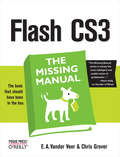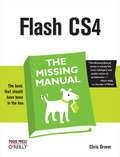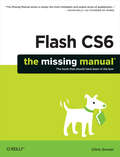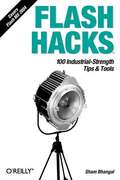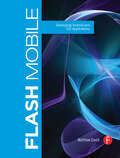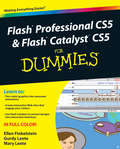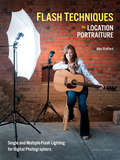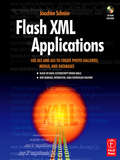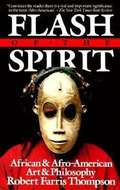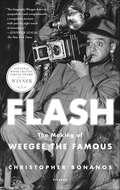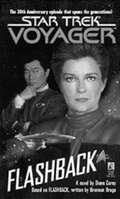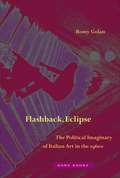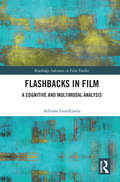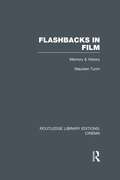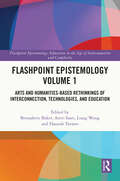- Table View
- List View
Flash CS3: The Missing Manual
by Chris Grover E. A. Vander VeerFlash CS3 is the premier tool for creating web animations and interactive web sites, can be intimidating to learn. This entertaining reference tutorial provides a reader-friendly animation primer and a guided tour of all the program's tools and capabilities. Beginners will learn to use the software in no time, and experienced users will quickly take their skills to the next level. The book gives Flash users of all levels hands-on instructions to help them master:Special effectsMorphingAdding audio and video Introducing interactivity And much moreWith Flash CS3: The Missing Manual you'll be able to turn an idea into a Flash animation, tutorial, or movie. This book will help you create online tutorials, training materials and full-blown presentations. It also teaches design principles throughout and helps you avoid elements that can distract or annoy an audience.This is the first new release of Flash since Adobe bought Macromedia, which means that it's the first version that will integrate easily with other Adobe products. It's a whole new ballgame when it comes to Flash, and Flash CS3: The Missing Manual offers you complete and objective coverage. It's the perfect companion to this powerful software.
Flash CS3: The Missing Manual
by E. A. Vander Veer Christopher GroverFlash CS3, the latest version of the premier tool for creating web animations and interactive web sites, can be intimidating to learn. This entertaining reference tutorial provides a reader-friendly animation primer and a guided tour of all the program's tools and capabilities. Beginners will learn to use the software in no time, and experienced users will quickly take their skills to the next level. The book gives Flash users of all levels hands-on instructions to help them master: * Special effects * Morphing * Adding audio and video * Introducing interactivity * And much more With Flash CS3: The Missing Manual you'll be able to turn an idea into a Flash animation, tutorial, or movie. This book will help you create online tutorials, training materials and full-blown presentations. It also teaches design principles throughout and helps you avoid elements that can distract or annoy an audience. This is the first new release of Flash since Adobe bought Macromedia, which means that it's the first version that will integrate easily with other Adobe products. It's a whole new ballgame when it comes to Flash, and Flash CS3: The Missing Manual offers you complete and objective coverage. It's the perfect companion to this powerful software.
Flash CS4: The Missing Manual (The\missing Manual Ser.)
by Chris GroverUnlock the power of Flash and bring gorgeous animations to life onscreen. It's easy with Flash CS4: The Missing Manual. You'll start creating animations in the first chapter, and will learn to produce effective, well-planned visuals that get your message across. This entertaining new edition includes a complete primer on animation, a guided tour of the program's tools, lots of new illustrations, and more details on working with video. Beginners will learn to use the software in no time, and experienced Flash designers will improve their skills. Expanded and revised to cover the new version of Flash, every chapter in this book provides step-by-step tutorials to help you:Learn to draw objects, animate them, and integrate your own audio and video filesAdd interactivity, use special effects, learn morphing, and much moreCheck your work with the book's online example files and completed animationsDiscover new Flash toolkits and features such as Frameless AnimationUse every timesaving aspect of Flash CS4, such as Library objects and SymbolsLearn how to automate your drawings and animations with ActionScript 3.0With this book, absolutely no programming is necessary to get started with Flash CS4. Flash CS4: The Missing Manual explains in jargon-free English exactly what you need to know to use Flash effectively, while avoiding common pitfalls, right from the start.
Flash CS5.5: The Missing Manual (The\missing Manual Ser.)
by Chris GroverYou can build everything from simple animations to full-fledged iOS and Android apps with Flash CS5.5, but learning this complex program can be difficult—unless you have this fully updated, bestselling guide. Learn how to create gorgeous Flash effects even if you have no programming experience. With Flash CS5.5: The Missing Manual, you'll move from the basics to power-user tools with ease.Learn animation basics. Discover how to turn simple ideas into stunning animations.Master Flash's tools. Learn the animation and effects tools with clear explanations and hands-on examples.Use 3D effects. Rotate objects and make them move in three dimensions.Create lifelike motion. Use the IK Bones tool to simulate realistic body movements and other linked motions.Build apps for tablets and smartphones. Create the next generation of iPhone, iPad, and Android apps.Add multimedia. Incorporate your own audio and video files into Flash.Create rich interactive animations. Dive into advanced interactivity with easy-to-learn ActionScript examples.
Flash CS5: The Missing Manual (The\missing Manual Ser.)
by Chris GroverOnce you know how to use Flash, you can create everything from simple animations to high-end desktop applications, but it's a complex tool that can be difficult to master on your own-unless you have this Missing Manual. This book will help you learn all you need to know about Flash CS5 to create animations that bring your ideas to life.Learn animation basics. Find everything you need to know to get started with FlashMaster the Flash tools. Learn the animation and effects toolset, with clear explanations and hands-on examplesUse 3D effects. Rotate and put objects in motion in three dimensionsCreate lifelike motion. Use the IK Bones tool to simulate realistic body movements and other linked motionsSpeed up development. Use templates, code snippets, and motion presetsDesign applications. Get an intro to building full desktop applications with Flash and Adobe AIRCreate rich interactive animations. Dive into advanced interactivity with easy-to-learn ActionScript examples
Flash CS6: The Missing Manual
by Chris Grover<p>You can build everything from simple animations to full-fledged iPhone, iPad, and Android apps with Flash CS6, but learning this complex program can be difficult—unless you have this fully updated, bestselling guide. Learn how to create gorgeous Flash effects even if you have no programming experience. With <i>Flash CS6: The Missing Manual</i>, you’ll move from the basics to power-user tools with ease.</p>
Flash Cinematic Techniques: Enhancing Animated Shorts and Interactive Storytelling
by Chris JacksonApply universally accepted cinematic techniques to your Flash projects to improve the storytelling quotient in your entertainment, advertising (branding), and educational media. A defined focus on the concepts and techniques for production from story reels to the final project delivers valuable insights, time-saving practical tips, and hands-on techniques for great visual stories. Extensive illustration, step-by-step instruction, and practical exercises provide a hands-on perspective.Explore the concepts and principles of visual components used in stories so you are fluent in the use of space, line, color, and movement in communicating emotion and meaning. Apply traditional cinematography techniques into the Flash workspace with virtual camera movements, simulated 3d spaces, lighting techniques, and character animation. Add interactivity using ActionScript to enhance audience participation.
Flash Flaherty: Tales from a Film Seminar
by Julia TulkeFlash Flaherty, the much-anticipated follow-up volume to The Flaherty: Decades in the Cause of Independent Cinema, offers a people's history of the world-renowned Robert Flaherty Film Seminar, an annual event where participants confront and reimagine the creative process surrounding multiple document/documentary forms and modes of the moving image.This collection, which includes a mosaic of personal recollections from attendees of the Flaherty Seminar over a span of more than 60 years, highlights many facets of the "Flaherty experience." The memories of the seminarians reveal how this independent film and media seminar has created a lively and sometimes cantankerous community within and beyond the institutionalized realm of American media culture. Editors Scott MacDonald and Patricia R. Zimmermann have curated a collective polyphonic account that moves freely between funny anecdotes, poetic impressions, critical considerations, poignant recollections, scholarly observations, and artistic insights. Together, the contributors to Flash Flaherty exemplify how the Flaherty Seminar propels shared insights, challenging debates, and actual change in the world of independent media.
Flash Hacks
by Sham BhangalIf you've ever seen an especially cool Flash effect on the web, gone straight to your trusty Flash book to find out how to do it, then turned away empty-handed-- Flash Hacks is for you. This unique book offers a collection of expert Flash tips and tricks for optimization, creating interesting effects, ActionScript programming, sound and video effects, and much more--and you don't need to be an expert to use them (although you'll certainly look like one). With Flash technology, you can create compelling web content, expressive user interfaces, and rich applications for the Internet--all of which dramatically enhance the user experience. But Flash is not just practical, it's a wellspring of opportunities to unleash your creativity and have fun. Flash Hacks dives straight into all that's fun and creative about Flash, while presenting useful programming techniques and practical--although never mundane--hacks that can make your work easier. Geared to cover Flash MX, Flash MX 2004, and Flash MX Professional 2004, Flash Hacks begins with hacks on authoring, testing, and web environments. You'll learn how to beat the Flash bloat bug, realistically simulate the web, create a JavaScript-free Flash sniffer, and hack a spellchecker for Flash. Other hacks in the book are grouped in the following areas: Primitives Timelines Symbols Flash Assets (sound, video, and bitmaps) Code hacks Events and event handling Advanced animation UI design hacks True to O'Reilly's popular Hacks series, Flash Hacks tackles problems and solutions that aren't dealt with elsewhere. You'll pick up insider tips from the experts, and learn about amazing and sometimes quirky aspects of Flash. If you want more than your average Flash user--you want to explore and experiment, unearth shortcuts, create useful tools, and come up with fun things to try on your own-- Flash Hacks is the book you'll need.
Flash Mobile: Developing Android and iOS Applications (Visualizing The Web Ser.)
by Matthew DavidBuild rich media applications for the iOS and Android platforms with this primer to Flash mobile development. You get all of the essentials-from setting up your development environment to publishing your apps to the Google Market Place/Apple iTunes App Store. Develop elementary applications without coding; then realize the power of ActionScript 3 to add rich complexity to your applications. Step-by-step instruction is combined with practical tutorial lessons to deliver a working understanding of the development stages including: *Rapid prototyping *Adding interactivity, audio, and video *Employing iOS and Android Interface Calls *Hardware optimization with AIR *Game development; game engines, controlling physics, and 3D *Designing for iPad, Android tablets, and Google TV *Code optimization, testing, and debugging User interfaces are presented in full color to illustrate their nuances. The companion website, www.visualizetheweb/flashmobile, includes all of the AS3 code, project files, and a blog to keep you up to date with related news and developments.
Flash Multiplayer Virtual Worlds
by MakzanThis is a step-by-step, hands-on guide that is filled with examples and screenshots of building a multiplayer virtual world. The virtual world is built gradually; each chapter in the book sequentially develops the virtual world. The author explains the fundamentals with examples from existing virtual worlds such as Club Penguin, Mole, Dofus, and World of Warcraft. If you are a Flash or an ActionScript developer who wants to build powerful and immersive multiplayer games, this book is for you. This book assumes that you have some experience with ActionScript 3.0.
Flash Professional CS5 & Flash Catalyst CS5 For Dummies
by Ellen Finkelstein Gurdy Leete Mary LeeteA full-color guide for getting rewarding results with Flash CS5!Flash is used in the creation of web animation, games, media rich websites, presentations, and more. Adobe's Flash CS5 product has been divided into three separate products custom-tailored for different audiences, and this book covers the Professional product; the traditional animation/media serving tool; and Catalyst, the web/interface design tool. This book provides a fun and friendly full-color guide to Flash and all it can do to add some flair to your site.Walks you through both Professional and Catalyst as well as the traditional Flash animation toolOffers guidance for getting acquainted with the interface; creating images, objects, text, and layers for animation; and working with symbols and buttonsIntroduces using Flash for online publishing and mobile designsAddresses how to turn existing images into interactive sites or interfaces with CatalystOffers helpful tips on troubleshooting and best practices for creating interactive websitesUsing the knowledge you gain from Flash CS5 Professional & Flash CS5 Catalyst For Dummies, you'll quickly prove that you are not a flash in the pan!
Flash Techniques for Location Portraiture
by Alyn StaffordThis book offers insights on mastering the use of small-unit, hot shoe-mounted flashes called flashguns.
Flash Techniques for Location Portraiture
by Alyn StaffordThis book offers insights on mastering the use of small-unit, hot shoe-mounted flashes called flashguns.
Flash XML Applications: Use AS2 and AS3 to Create Photo Galleries, Menus, and Databases
by Joachim Bernhard SchnierAdd seamless, interactive, user-controlled delivery to your Flash applications. This book builds upon your understanding of basic ActionScript (AS) syntax with the foundational skills that you need to use XML in Flash applications and AS2 or AS3 to migrate your existing applications. Beginning with an introduction to XML, XML parsing methods, and a short introduction to AS2 you learn how to create a universal XML load/onload Class as well as a universal XHTML parser. Then you learn how to use Components using XML as the data source, including the menu, menubar, datagrid and tree component. Finally, a tutorial project-the design and development of a Real Estate Web site that contains an XML search engine-pulls it all together with hands-on experience. All the applications use XML as the data source and are written as class files. Select parts of the Real Estate Web site are redeveloped in AS3 for purposes of illustration. The new XML class is presented and specific code examples demonstrate techniques to apply methods and use properties. Particular attention is paid to the differences between AS2 and AS3 and how to effectively transition from one AS version to the other.The companion CD contains code for all of the properties and methods of the AS2, AS3, and XML class examples. Components for the Real Estate Web site project are also provided.
Flash of the Spirit: African and Afro-American Art and Philosophy
by Robert Farris ThompsonThis book reveals how five distinct African civilizations have shaped the specific cultures of their New World descendants.
Flash: The Making of Weegee the Famous
by Christopher BonanosWinner of the National Book Critics Circle AwardThe first comprehensive biography of Weegee—photographer, “psychic,” ultimate New Yorker—from Christopher Bonanos, author of Instant: The Story of Polaroid.Arthur Fellig’s ability to arrive at a crime scene just as the cops did was so uncanny that he renamed himself “Weegee,” claiming that he functioned as a human Ouija board. Weegee documented better than any other photographer the crime, grit, and complex humanity of midcentury New York City. In Flash, we get a portrait not only of the man (both flawed and deeply talented, with generous appetites for publicity, women, and hot pastrami) but also of the fascinating time and place that he occupied.From self-taught immigrant kid to newshound to art-world darling to latter-day caricature—moving from the dangerous streets of New York City to the celebrity culture of Los Angeles and then to Europe for a quixotic late phase of experimental photography and filmmaking—Weegee lived a life just as worthy of documentation as the scenes he captured. With Flash, we have an unprecedented and ultimately moving view of the man now regarded as an innovator and a pioneer, an artist as well as a newsman, whose photographs are among most powerful images of urban existence ever made.
Flashback (Star Trek)
by Diane CareyA hundred years before the Starship VoyagerTM was transported to the Delta Quadrant, Lieutenant Tuvok served under one of Starfleet's most famous officers: Captain Hikaru Sulu of the Starship ExcelsiorTM. Now those days have come back to haunt him. While traveling through an uncharted nebula, Tuvok is besieged by recurring memories of his time with Captain Sulu -- repressed memories that may well kill him unless their source is determined in time. To save her closest friend, Captain Kathryn Janeway follows Tuvok to the century-old bridge of the Excelsior during a desperate battle. There Tuvok, Captain Janeway, Captain Sulu and Commander Janice Rand must face a menace to galactic life unlike anything known before. . . .
Flashback, Eclipse: The Political Imaginary of Italian Art in the 1960s
by Romy GolanFrom a leading art historian, a provocative exploration of the intersection of art, politics, and historical memory in 1960s Italy.Flashback, Eclipse is a groundbreaking study of 1960s Italian art and its troubled but also resourceful relation to the history and politics of the first part of the twentieth century and the aftermath of World War II. Most analyses have treated the 1960s in Italy as the decade of “presentism” par excellence, a political decade but one liberated from history. Romy Golan, however, makes the counterargument that 1960s Italian artists did not forget Italian and European history but rather reimagined it in oblique form. Her book identifies and explores this imaginary through two forms of nonlinear and decidedly nonpresentist forms of temporality—the flashback and the eclipse. In view of the photographic and filmic nature of these two concepts, the book’s analysis is largely mediated by black-and-white images culled from art, design, and architecture magazines, photo books, film stills, and exhibition documentation.The book begins in Turin with Michelangelo Pistoletto’s Mirror Paintings; moves on to Campo urbano, a one-day event in the city of Como; and ends with the Vitalità del Negativo exhibition in Rome. What is being recalled and at other moments occluded are not only episodes of Italian nationalism and Fascism but also various liberatory moments of political and cultural resistance. The book’s main protagonists are, in order of appearance, artists Michelangelo Pistoletto and Giosetta Fioroni, photographer Ugo Mulas, Ettore Sottsass (as critic rather than designer), graphic designer Bruno Munari, curators Luciano Caramel and Achille Bonito Oliva, architect Piero Sartogo, Carla Lonzi (as artist as much as critic), filmmakers Michelangelo Antonioni and Bernardo Bertolucci, and, in flashback among the departed, painter Felice Casorati, writer Massimo Bontempelli, art historian Aby Warburg, architect Giuseppe Terragni, and Renaissance friar-philosopher-mathematician Giordano Bruno (as patron saint of the sixty-eighters).
Flashbacks in Film: A Cognitive and Multimodal Analysis (Routledge Advances in Film Studies)
by Adriana GordejuelaFlashbacks in Film examines fi lm fl ashback as a rich multimodal narrative device, analyzing the cognitive underpinnings of fi lm fl ashbacks and the mechanisms that lead viewers to successfully comprehend them. Combining a cognitive fi lm theory approach with the theoretical framework proposed by blending theory, which claims that human beings’ general ability for conceptual integration underlies most of our daily activities, this book argues that fl ashbacks make sense to the viewer, as they are specifi cally designed for the viewer’s cognitive understanding. Through a mixture of analysis and dozens of case studies, this book demonstrates that successful fi lm fl ashbacks appeal to the spectator’s natural perceptual and cognitive abilities, which spectators exercise daily. This book will serve as a valuable resource for scholars interested in film studies, media studies, and cognitive linguistics.
Flashbacks in Film: Memory & History (Routledge Library Editions: Cinema)
by Maureen TurimThe flashback is a crucial moment in a film narrative, one that captures the cinematic expression of memory, and history. This author’s wide-ranging account of this single device reveals it to be an important way of creating cinematic meaning. Taking as her subject all of film history, the author traces out the history of the flashback, illuminating that history through structuralist narrative theory, psychoanalytic theories of subjectivity, and theories of ideology. From the American silent film era and the European and Japanese avant-garde of the twenties, from film noir and the psychological melodrama of the forties and fifties to 1980s art and Third World cinema, the flashback has interrogated time and memory, making it a nexus for ideology, representations of the psyche, and shifting cultural attitudes.
Flashes of Brilliance: The Genius of Early Photography and How It Transformed Art, Science, and History
by Anika BurgessThe story of the wildest experiments in early photography and the wild people who undertook them. Today it’s routine to take photos from an airplane window, use a camera underwater, or watch a movie or view an X-ray. But the photographic innovations more than a century ago that made such things possible were experimental, revelatory, and sometimes dangerous—and many of the innovators, entrepreneurs, and inventors behind them were memorable eccentrics. In Flashes of Brilliance, New York Times photo editor Anika Burgess engagingly blends art, science, and social history to reveal the most dramatic developments in photography from its birth in the 1830s to the early twentieth century. Writing with verve and and an eye for the compelling detail, Burgess explores how photographers uncovered new vistas, including dark caves and catacombs, cities at night, the depths of the ocean, and the surface of the moon. She describes how photographers captured the world as never seen before, showing for the first time the bones of humans, the motion of animals, the cells of plants, and the structure of snowflakes. She takes us on a tour of astonishing innovations, including botanist Anna Atkins and her extraordinary blue-hued cyanotypes and the world’s first photobook; Eadweard Muybridge and Étienne-Jules Marey’s famed experiments in capturing motion and their long legacy; the work of Nadar, Carleton E. Watkins, and other leading pioneers of large-scale photography; and aerial photography using balloons, kites, and pigeons. Burgess also delves into the early connections between photography and society that are still with us today: how photo manipulation—the art of “fake images”—was an issue right from the start; how the police used the telephoto lens to surveil suffragists and others; and how leading Black figures like Sojourner Truth and Frederick Douglass adapted self-portraits to assert their identity and autonomy. Richly illustrated and filled with fascinating tales, Flashes of Brilliance shows how the rise of a new art form transformed culture and our view of the world.
Flashpoint Epistemology Volume 1: Arts and Humanities-Based Rethinkings of Interconnection, Technologies, and Education (Flashpoint Epistemology)
by Liang Wang Bernadette Baker Antti Saari Hannah TavaresThe 21st century is steeped in claims to interconnection, technological innovation, and new affective intensities amid challenges to the primacy and centrality of "the human". Flashpoint epistemology attends to the lived difficulties that arise in teaching, policymaking, curriculum, and research among continuous practices of differentiation, and for which there is no pre-existing template for judgment, resolution, or action. Flashpoint Epistemology Volume 1 examines contemporary collisions and reworkings of cultural-political issues in education through arts and humanities-based approaches. How and whether lines are (re)drawn in educational practice – and via who-what – between justice, morality, religion, ethics, subjectivities, intersectionality, the sublime, and the senses are a particular focus. The volume offers innovative relational approaches and new narrativization strategies, examining the aporia experienced when operating in educational domains of inevitable, recurring, difficult, fortuitous, and/or unforeseen flashpoints. The chapters will engage researchers seeking new approaches to education’s complexities, nested discourses, and ever-moving horizons of enactment. It will also benefit post/graduate students and teachers whose work intersects with sociological, philosophical, and cultural studies and who are curious about claims to interconnection, the ethical quandaries embedded in practice, and the affordances and limits of technological innovation.
Flat Rock
by Stacey Reynolds Flat Rock Historical SocietyLocated between Monroe and Detroit in Michigan, Flat Rock's history begins with the Wyandot, Huron, and Seneca Indians who once hunted and fished along the Huron River. Founded in 1823 by Michael Vreelandt, the area started to grow and prosper when settlers discovered the fertile lands and waterpower of the Huron River. The power of the river attracted settlers to build and operate two sawmills, a flour mill, and a blacksmith shop. When Pres. Abraham Lincoln called for volunteers to join the Civil War, many men from Flat Rock enlisted under Walter H. Wallace's encouragement. The largest number of volunteers came from Michigan, and that state suffered the largest number of wounded at the Battle of Gettysburg. Discover the town's story through these archival images from the Flat Rock Historical Society, showcasing the businesses, churches, community, and people whose hard work helped the city to prosper.
Flat Rock
by Galen ReutherNamed for the great expanse of rock where the Cherokee Indians used to spend their summers, Flat Rock, North Carolina, is beautifully situated near the Continental Divide in the Blue Ridge Mountains. Flat Rock is known as "the Little Charleston of the Mountains," thanks to the pioneering Lowcountry settlers who flocked to the area after the Revolutionary War. These prominent South Carolina families, drawn to the refreshing cool mountain air that offered relief from the steamy Charleston summers, purchased vast quantities of land and built grand estates for their residences or summer getaways. The photographs in Images of America: Flat Rock illustrate the gorgeous homes and attractions of this National Historic Site, including the Flat Rock Playhouse and St. John in the Wilderness Church, the oldest Episcopal Church in western North Carolina.
